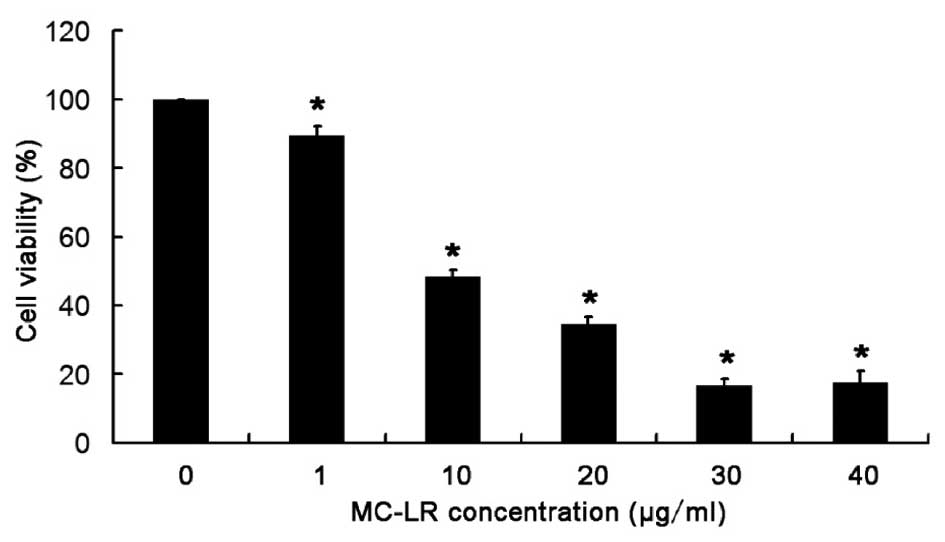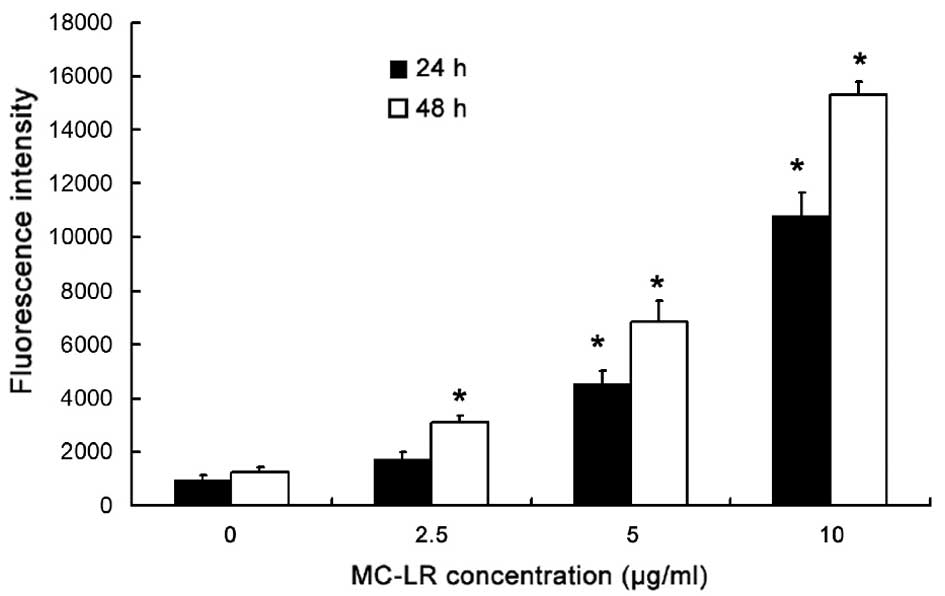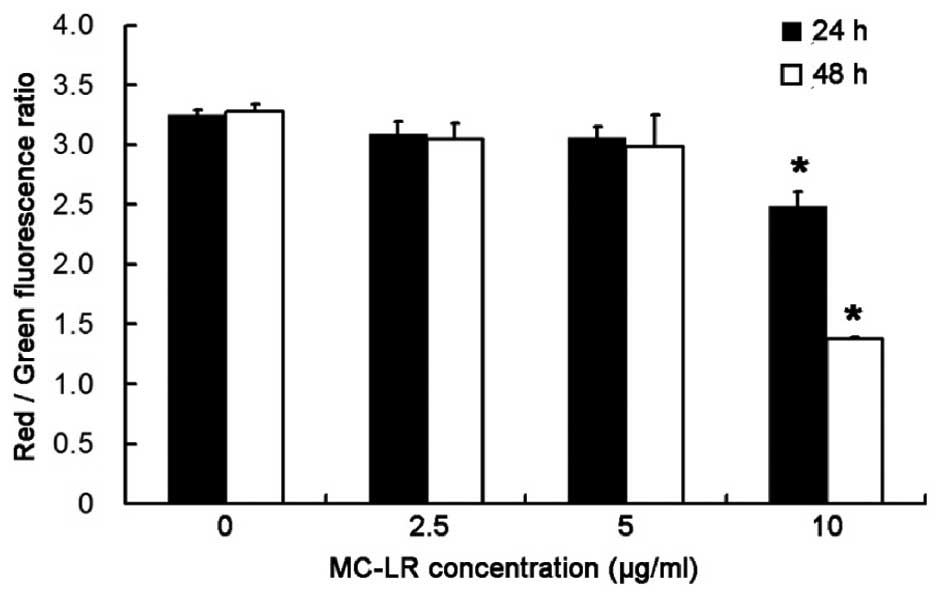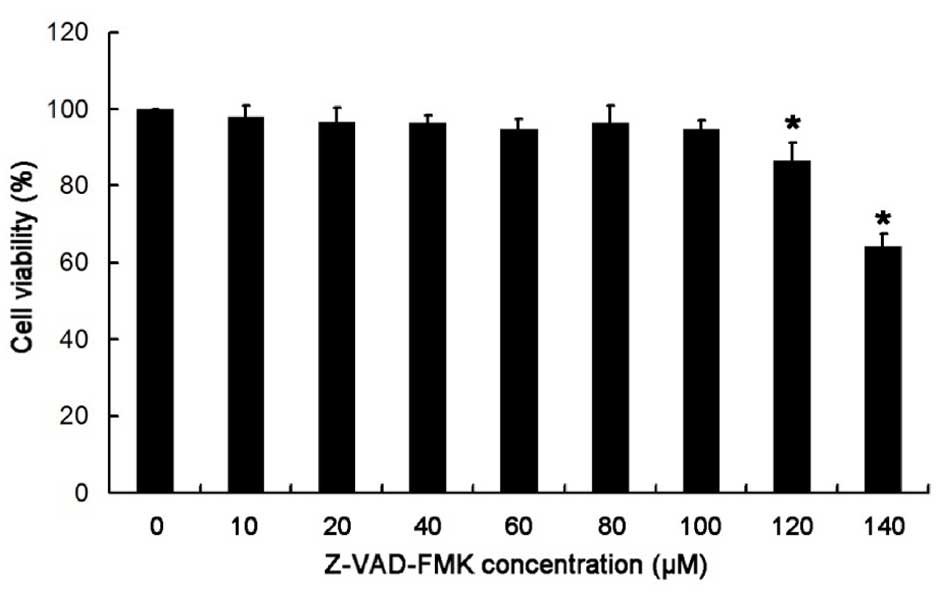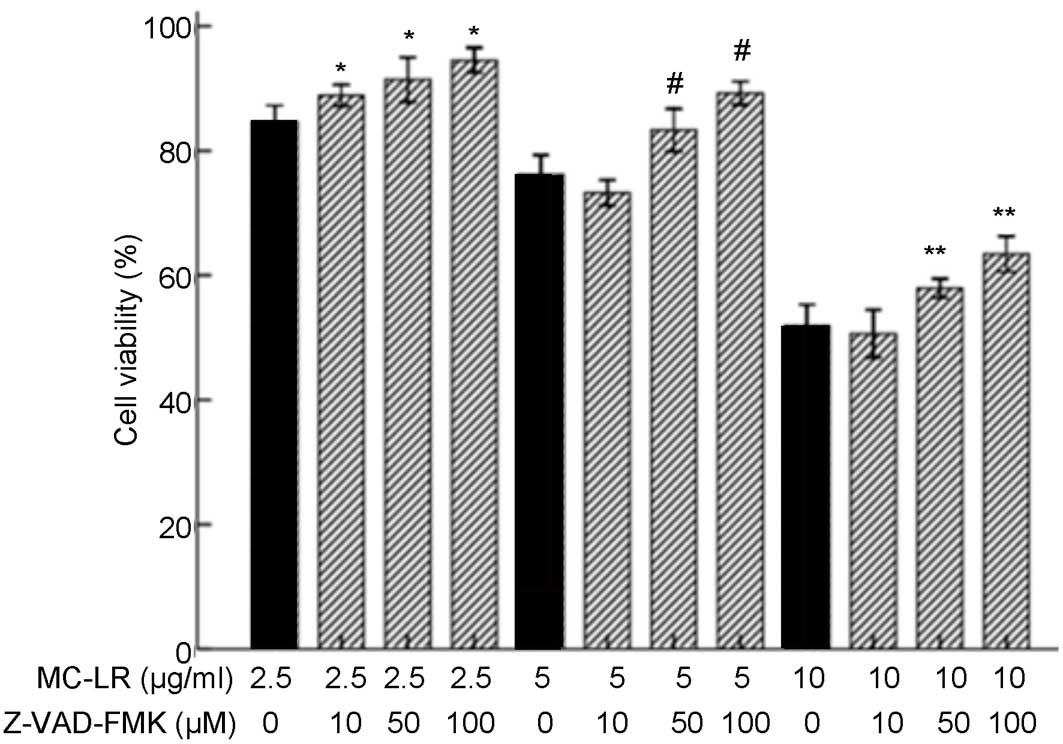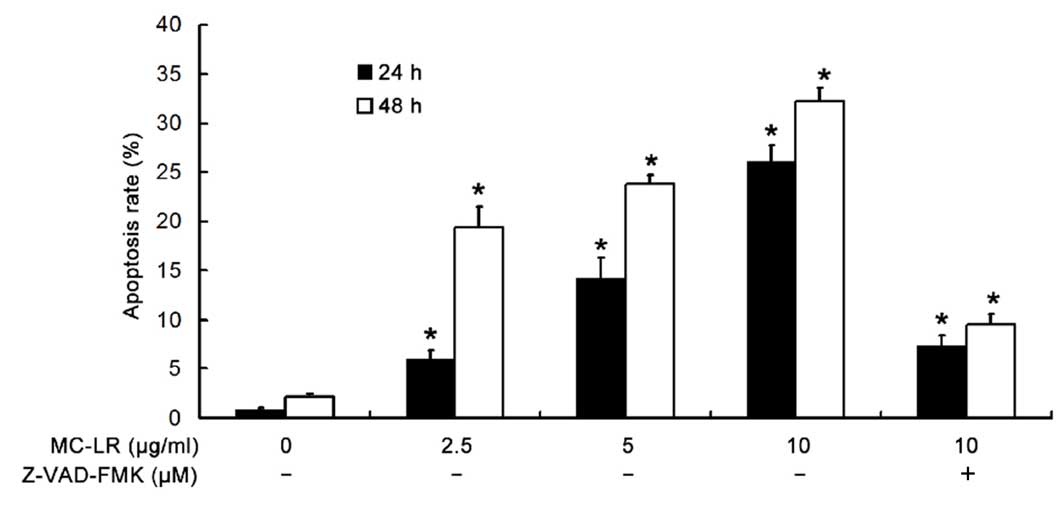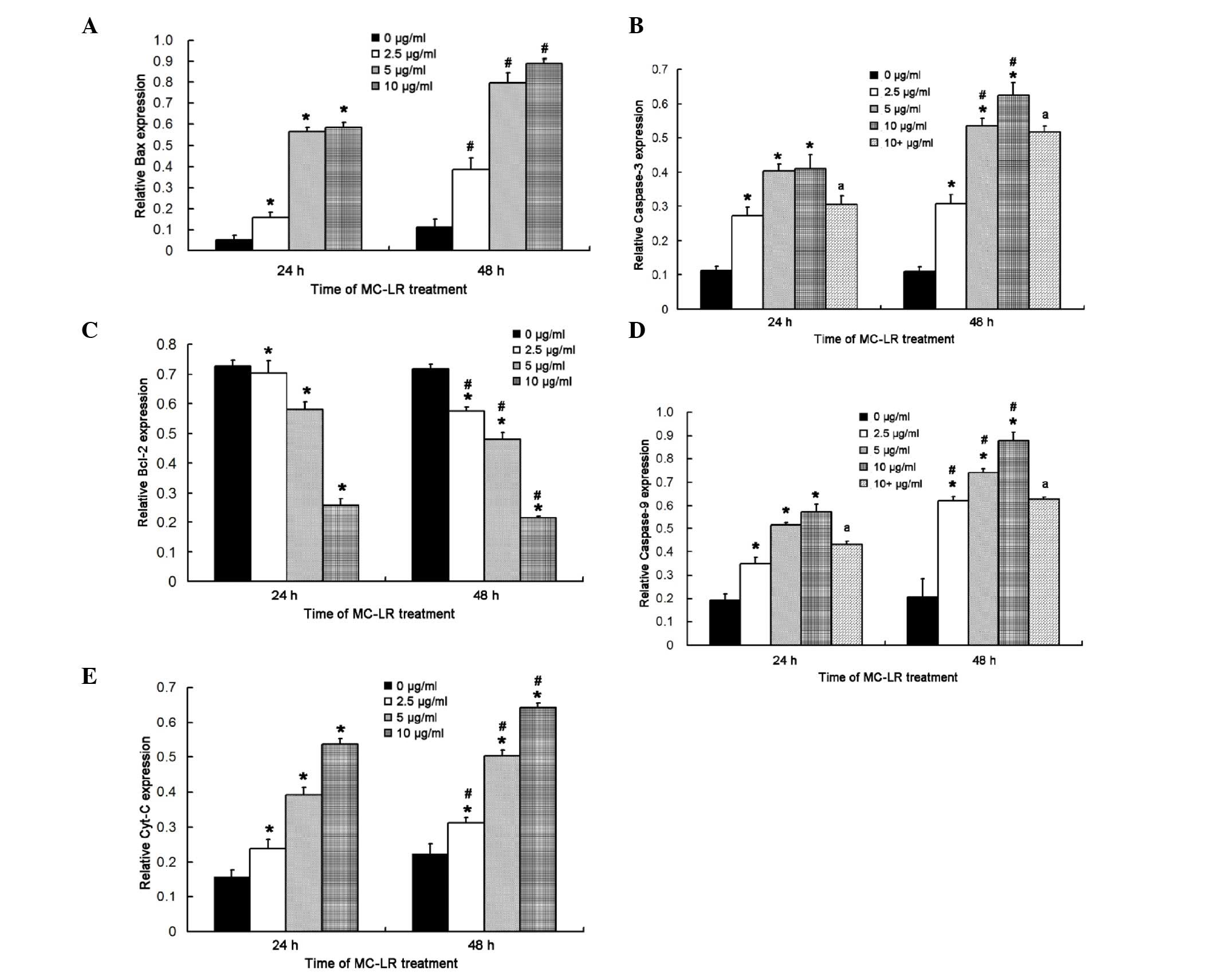|
1
|
Wood R: Acute animal and human poisonings
from cyanotoxin exposure - a review of the literature. Environ Int.
91:276–282. 2016. View Article : Google Scholar : PubMed/NCBI
|
|
2
|
Chen DN, Zeng J, Wang F, Zheng W, Tu WW,
Zhao JS and Xu J: Hyperphosphorylation of intermediate filament
proteins is involved in microcystin-LR-induced toxicity in HL7702
cells. Toxicol Lett. 214:192–199. 2012. View Article : Google Scholar : PubMed/NCBI
|
|
3
|
Zhou Y, Chen Y, Yuan M, Xiang Z and Han X:
In vivo study on the effects of microcystin-LR on the
apoptosis, proliferation and differentiation of rat testicular
spermatogenic cells of male rats injected i.p. with toxins. J
Toxicol Sci. 38:661–670. 2013. View Article : Google Scholar : PubMed/NCBI
|
|
4
|
Christen V, Meili N and Fent K:
Microcystin-LR induces endoplasmatic reticulum stress and leads to
induction of NFκB, interferon-alpha, and tumor necrosis
factor-alpha. Environ Sci Technol. 47:3378–3385. 2013.PubMed/NCBI
|
|
5
|
Carmichael WW, Azevedo SM, An JS, Molica
RJ, Jochimsen EM, Lau S, Rinehart KL, Shaw GR and Eaglesham GK:
Human fatalities from cyanobacteria: Chemical and biological
evidence for cyanotoxins. Environ Health Perspect. 109:663–668.
2001. View Article : Google Scholar : PubMed/NCBI
|
|
6
|
Oliveira VR, Mancin VG, Pinto EF, Soares
RM, Azevedo SM, Macchione M, Carvalho AR and Zin WA: Repeated
intranasal exposure to microcystin-LR affects lungs but not nasal
epithelium in mice. Toxicon. 104:14–18. 2015. View Article : Google Scholar : PubMed/NCBI
|
|
7
|
Duy TN, Lam PK, Shaw GR and Connell DW:
Toxicology and risk assessment of freshwater cyanobacterial
(blue-green algal) toxins in water. Rev Environ Contam Toxicol.
163:113–185. 2000.PubMed/NCBI
|
|
8
|
Giannuzzi L, Sedan D, Echenique R and
Andrinolo D: An acute case of intoxication with cyanobacteria and
cyanotoxins in recreational water in Salto Grande Dam, Argentina.
Mar Drugs. 9:2164–2175. 2011. View Article : Google Scholar : PubMed/NCBI
|
|
9
|
Turner PC, Gammie AJ, Hollinrake K and
Codd GA: Pneumonia associated with contact with cyanobacteria. BMJ.
300:1440–1441. 1990. View Article : Google Scholar : PubMed/NCBI
|
|
10
|
Backer LC, McNeel SV, Barber T,
Kirkpatrick B, Williams C, Irvin M, Zhou Y, Johnson TB, Nierenberg
K, Aubel M, et al: Recreational exposure to microcystins during
algal blooms in two California lakes. Toxicon. 55:909–921. 2010.
View Article : Google Scholar : PubMed/NCBI
|
|
11
|
Pilotto LS, Douglas RM, Burch MD, Cameron
S, Beers M, Rouch GJ, Robinson P, Kirk M, Cowie CT, Hardiman S, et
al: Health effects of exposure to cyanobacteria (blue-green algae)
during recreational water-related activities. Aust N Z J Public
Health. 21:562–566. 1997. View Article : Google Scholar : PubMed/NCBI
|
|
12
|
Stewart I, Webb PM, Schluter PJ, Fleming
LE, Burns JW Jr, Gantar M, Backer LC and Shaw GR: Epidemiology of
recreational exposure to freshwater cyanobacteria - an
international prospective cohort study. BMC Public Health.
6:932006. View Article : Google Scholar : PubMed/NCBI
|
|
13
|
Backer LC, Carmichael W, Kirkpatrick B,
Williams C, Irvin M, Zhou Y, Johnson TB, Nierenberg K, Hill VR,
Kieszak SM and Cheng YS: Recreational exposure to low
concentrations of microcystins during an algal bloom in a small
lake. Mar Drugs. 6:389–406. 2008. View Article : Google Scholar : PubMed/NCBI
|
|
14
|
Schmeck B, Gross R, N'Guessan PD, Hocke
AC, Hammerschmidt S, Mitchell TJ, Rosseau S, Suttorp N and
Hippenstiel S: Streptococcus pneumoniae-induced caspase 6-dependent
apoptosis in lung epithelium. Infect Immun. 72:4940–4947. 2004.
View Article : Google Scholar : PubMed/NCBI
|
|
15
|
Walsh GM, Sexton DW and Blaylock MG:
Corticosteroids, eosinophils and bronchial epithelial cells: New
insights into the resolution of inflammation in asthma. J
Endocrinol. 178:37–43. 2003. View Article : Google Scholar : PubMed/NCBI
|
|
16
|
Li L, Qiu P, Chen B, Lu Y, Wu K, Thakur C,
Chang Q, Sun J and Chen F: Reactive oxygen species contribute to
arsenic-induced EZH2 phosphorylation in human bronchial epithelial
cells and lung cancer cells. Toxicol Appl Pharmacol. 276:165–170.
2014. View Article : Google Scholar : PubMed/NCBI
|
|
17
|
Myerburg MM, Latoche JD, McKenna EE,
Stabile LP, Siegfried JS, Feghali-Bostwick CA and Pilewski JM:
Hepatocyte growth factor and other fibroblast secretions modulate
the phenotype of human bronchial epithelial cells. Am J Physiol
Lung Cell Mol Physiol. 292:L1352–L1360. 2007. View Article : Google Scholar : PubMed/NCBI
|
|
18
|
Gao W, Li L, Wang Y, Zhang S, Adcock IM,
Barnes PJ, Huang M and Yao X: Bronchial epithelial cells: The key
effector cells in the pathogenesis of chronic obstructive pulmonary
disease? Respirology. 20:722–729. 2015. View Article : Google Scholar : PubMed/NCBI
|
|
19
|
Chen DJ, Xu YM, Du JY, Huang DY and Lau
AT: Cadmium induces cytotoxicity in human bronchial epithelial
cells through upregulation of eIF5A1 and NF-kappaB. Biochem Biophys
Res Commun. 445:95–99. 2014. View Article : Google Scholar : PubMed/NCBI
|
|
20
|
Yoon DH, Lim MH, Lee YR, Sung GH, Lee TH,
Jeon BH, Cho JY, Song WO, Park H, Choi S and Kim TW: A novel
synthetic analog of Militarin, MA-1 induces mitochondrial dependent
apoptosis by ROS generation in human lung cancer cells. Toxicol
Appl Pharmacol. 273:659–671. 2013. View Article : Google Scholar : PubMed/NCBI
|
|
21
|
Alverca E, Andrade M, Dias E, Sam Bento F,
Batoréu MC, Jordan P, Silva MJ and Pereira P: Morphological and
ultrastructural effects of microcystin-LR from Microcystis
aeruginosa extract on a kidney cell line. Toxicon. 54:283–294.
2009. View Article : Google Scholar : PubMed/NCBI
|
|
22
|
Huang X, Chen L, Liu W, Qiao Q, Wu K, Wen
J, Huang C, Tang R and Zhang X: Involvement of oxidative stress and
cytoskeletal disruption in microcystin-induced apoptosis in CIK
cells. Aquat Toxicol. 165:41–50. 2015. View Article : Google Scholar : PubMed/NCBI
|
|
23
|
Li L, Xie P and Guo L: Antioxidant
response in liver of the phytoplanktivorous bighead carp
(Aristichthys nobilis) intraperitoneally-injected with extracted
microcystins. Fish Physiol Biochem. 36:165–172. 2010. View Article : Google Scholar : PubMed/NCBI
|
|
24
|
Turrens JF: Mitochondrial formation of
reactive oxygen species. J Physiol. 552:335–344. 2003. View Article : Google Scholar : PubMed/NCBI
|
|
25
|
Ding WX and Nam Ong C: Role of oxidative
stress and mitochondrial changes in cyanobacteria-induced apoptosis
and hepatotoxicity. FEMS Microbiol Lett. 220:1–7. 2003. View Article : Google Scholar : PubMed/NCBI
|
|
26
|
Zhao Y, Xie P, Tang R, Zhang X, Li L and
Li D: In vivo studies on the toxic effects of microcystins
on mitochondrial electron transport chain and ion regulation in
liver and heart of rabbit. Comp Biochem Physiol C Toxicol
Pharmacol. 148:204–210. 2008. View Article : Google Scholar : PubMed/NCBI
|
|
27
|
Zhang HZ, Zhang FQ, Li CF, Yi D, Fu XL and
Cui LX: A cyanobacterial toxin, microcystin-LR, induces apoptosis
of sertoli cells by changing the expression levels of
apoptosis-related proteins. Tohoku J Exp Med. 224:235–242. 2011.
View Article : Google Scholar : PubMed/NCBI
|
|
28
|
Shah P, Djisam R, Damulira H, Aganze A and
Danquah M: Embelin inhibits proliferation, induces apoptosis and
alters gene expression profiles in breast cancer cells. Pharmacol
Rep:. 68:638–644. 2016. View Article : Google Scholar : PubMed/NCBI
|
|
29
|
Afri M, Frimer AA and Cohen Y: Active
oxygen chemistry within the liposomal bilayer. Part IV: Locating
2′,7′-dichlorofluorescein (DCF), 2′,7′-dichlorodihydrofluorescein
(DCFH) and 2′,7′-dichlorodihydrofluorescein diacetate (DCFH-DA) in
the lipid bilayer. Chem Phys Lipids. 131:123–133. 2004. View Article : Google Scholar : PubMed/NCBI
|
|
30
|
Helm A, Lee R, Durante M and Ritter S: The
Influence of C-Ions and X-rays on human umbilical vein endothelial
cells. Front Oncol. 6:52016. View Article : Google Scholar : PubMed/NCBI
|
|
31
|
MacKintosh C, Beattie KA, Klumpp S, Cohen
P and Codd GA: Cyanobacterial microcystin-LR is a potent and
specific inhibitor of protein phosphatases 1 and 2A from both
mammals and higher plants. FEBS Lett. 264:187–192. 1990. View Article : Google Scholar : PubMed/NCBI
|
|
32
|
Kawamoto M, Fujiwara A and Yasumasu I:
Changes in the activities of protein phosphatase type 1 and type 2A
in sea urchin embryos during early development. Dev Growth Differ.
42:395–405. 2000. View Article : Google Scholar : PubMed/NCBI
|
|
33
|
Xue L, Li J, Li Y, Chu C, Xie G, Qin J,
Yang M, Zhuang D, Cui L, Zhang H and Fu X: N-acetylcysteine
protects Chinese Hamster ovary cells from oxidative injury and
apoptosis induced by microcystin-LR. Int J Clin Exp Med.
8:4911–4921. 2015.PubMed/NCBI
|
|
34
|
Rymuszka A: Microcystin-LR induces
cytotoxicity and affects carp immune cells by impairment of their
phagocytosis and the organization of the cytoskeleton. J Appl
Toxicol. 33:1294–1302. 2013.PubMed/NCBI
|
|
35
|
Sun Y, Meng GM, Guo ZL and Xu LH:
Regulation of heat shock protein 27 phosphorylation during
microcystin-LR-induced cytoskeletal reorganization in a human liver
cell line. Toxicol Lett. 207:270–277. 2011. View Article : Google Scholar : PubMed/NCBI
|
|
36
|
Vyssokikh MY, Antonenko YN, Lyamzaev KG,
Rokitskaya TI and Skulachev VP: Methodology for use of
mitochondria-targeted cations in the field of oxidative
stress-related research. Methods Mol Biol. 1265:149–159. 2015.
View Article : Google Scholar : PubMed/NCBI
|
|
37
|
Chen L, Zhang X, Zhou W, Qiao Q, Liang H,
Li G, Wang J and Cai F: The interactive effects of cytoskeleton
disruption and mitochondria dysfunction lead to reproductive
toxicity induced by microcystin-LR. PloS One. 8:e539492013.
View Article : Google Scholar : PubMed/NCBI
|
|
38
|
Oh SH and Lim SC: A rapid and transient
ROS generation by cadmium triggers apoptosis via caspase-dependent
pathway in HepG2 cells and this is inhibited through
N-acetylcysteine-mediated catalase upregulation. Toxicol Appl
Pharmacol. 212:212–223. 2006. View Article : Google Scholar : PubMed/NCBI
|
|
39
|
Ding WX, Shen HM and Ong CN: Critical role
of reactive oxygen species and mitochondrial permeability
transition in microcystin-induced rapid apoptosis in rat
hepatocytes. Hepatology. 32:547–555. 2000. View Article : Google Scholar : PubMed/NCBI
|
|
40
|
Zhao M, Zhang Y, Wang C, Fu Z, Liu W and
Gan J: Induction of macrophage apoptosis by an organochlorine
insecticide acetofenate. Chem Res Toxicol. 22:504–510. 2009.
View Article : Google Scholar : PubMed/NCBI
|
|
41
|
Li G, Bush JA and Ho VC: p53-dependent
apoptosis in melanoma cells after treatment with camptothecin. J
Invest Dermatol. 114:514–519. 2000. View Article : Google Scholar : PubMed/NCBI
|
|
42
|
Ji YB, Ji CF and Yue L: Study on human
promyelocytic leukemia HL-60 cells apoptosis induced by fucosterol.
Biomed Mater Eng. 24:845–851. 2014.PubMed/NCBI
|
|
43
|
Vander Heiden MG, Chandel NS, Williamson
EK, Schumacker PT and Thompson CB: Bcl-xL regulates the membrane
potential and volume homeostasis of mitochondria. Cell. 91:627–637.
1997. View Article : Google Scholar : PubMed/NCBI
|
|
44
|
Kim HG, Song H, Yoon DH, Song BW, Park SM,
Sung GH, Cho JY, Park HI, Choi S, Song WO, et al: Cordyceps
pruinosa extracts induce apoptosis of HeLa cells by a caspase
dependent pathway. J Ethnopharmacol. 128:342–351. 2010. View Article : Google Scholar : PubMed/NCBI
|
|
45
|
Wiebe JP, Beausoleil M, Zhang G and
Cialacu V: Opposing actions of the progesterone metabolites,
5alpha-dihydroprogesterone (5alphaP) and 3alpha-dihydroprogesterone
(3alphaHP) on mitosis, apoptosis, and expression of Bcl-2, Bax and
p21 in human breast cell lines. J Steroid Biochem Mol Biol.
118:125–132. 2010. View Article : Google Scholar : PubMed/NCBI
|
|
46
|
Zhang H, Cai C, Fang W, Wang J, Zhang Y,
Liu J and Jia X: Oxidative damage and apoptosis induced by
microcystin-LR in the liver of Rana nigromaculata in vivo.
Aquat Toxicol. 140–141:11–18. 2013. View Article : Google Scholar
|
|
47
|
Spencer SL and Sorger PK: Measuring and
modeling apoptosis in single cells. Cell. 144:926–939. 2011.
View Article : Google Scholar : PubMed/NCBI
|
|
48
|
Ferri KF and Kroemer G: Mitochondria––the
suicide organelles. BioEssays. 23:111–115. 2001. View Article : Google Scholar : PubMed/NCBI
|
|
49
|
Zhang S, Zhang Y, Zhuang Y, Wang J, Ye J,
Zhang S, Wu J, Yu K and Han Y: Matrine induces apoptosis in human
acute myeloid leukemia cells via the mitochondrial pathway and Akt
inactivation. PLoS One. 7:e468532012. View Article : Google Scholar : PubMed/NCBI
|
|
50
|
Xiong Q, Xie P, Li H, Hao L, Li G, Qiu T
and Liu Y: Involvement of Fas/FasL system in apoptotic signaling in
testicular germ cells of male Wistar rats injected i.v. with
microcystins. Toxicon. 54:1–7. 2009. View Article : Google Scholar : PubMed/NCBI
|
|
51
|
Fladmark KE, Brustugun OT, Hovland R, Boe
R, Gjertsen BT, Zhivotovsky B and Døskeland SO: Ultrarapid
caspase-3 dependent apoptosis induction by serine/threonine
phosphatase inhibitors. Cell Death Differ. 6:1099–1108. 1999.
View Article : Google Scholar : PubMed/NCBI
|
|
52
|
Hirata H, Takahashi A, Kobayashi S,
Yonehara S, Sawai H, Okazaki T, Yamamoto K and Sasada M: Caspases
are activated in a branched protease cascade and control distinct
downstream processes in Fas-induced apoptosis. J Exp Med.
187:587–600. 1998. View Article : Google Scholar : PubMed/NCBI
|
|
53
|
Jänicke RU, Sprengart ML, Wati MR and
Porter AG: Caspase-3 is required for DNA fragmentation and
morphological changes associated with apoptosis. J Biol Chem.
273:9357–9360. 1998. View Article : Google Scholar : PubMed/NCBI
|
|
54
|
Woo M, Hakem R, Soengas MS, Duncan GS,
Shahinian A, Kägi D, Hakem A, McCurrach M, Khoo W, Kaufman SA, et
al: Essential contribution of caspase 3/CPP32 to apoptosis and its
associated nuclear changes. Genes Dev. 12:806–819. 1998. View Article : Google Scholar : PubMed/NCBI
|



